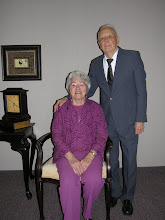 Farewell to Japan -Kimono I purchased and brought home.
Farewell to Japan -Kimono I purchased and brought home. Wilhelmine modeling kimono in hotel in Nara.
Wilhelmine modeling kimono in hotel in Nara.Nara is about 25 miles south of Kyoto and is older than the sister city. Beginning in 710, for 74 years Nara (then called Heijo) was capital of Japan.
 The Big Buddha measuring 16.2m in height and weighs 452 tons.
The Big Buddha measuring 16.2m in height and weighs 452 tons. Gold Spiral in Nara Park
Gold Spiral in Nara Park Kasugataisha Temple has 3000 lanterns
Kasugataisha Temple has 3000 lanterns.jpg) Wilhelmine standing in front of more lanterns at Kasugataisha Temple
Wilhelmine standing in front of more lanterns at Kasugataisha Temple
 Kofukuji Temple is famous for its five storied Pagoda (165 ft. high) built in 1426. In the 8th century Kifukuji Temple had almost 2300 buildings. Fire after fire leveled them and now the Pagoda and four haus are left.
Kofukuji Temple is famous for its five storied Pagoda (165 ft. high) built in 1426. In the 8th century Kifukuji Temple had almost 2300 buildings. Fire after fire leveled them and now the Pagoda and four haus are left. Todai-ji is the largest wooden building and its idol one of the largest bronze images of Buddha in the world.
Todai-ji is the largest wooden building and its idol one of the largest bronze images of Buddha in the world. Nara park is a woodsy expanse of hugh Japanese cedars, oaks and cypress trees. More than 1000 tame deer (called divine essengers) wander about the park during the day. At dusk, the call of a trumpet summons them to return to their pens.
Nara park is a woodsy expanse of hugh Japanese cedars, oaks and cypress trees. More than 1000 tame deer (called divine essengers) wander about the park during the day. At dusk, the call of a trumpet summons them to return to their pens.









































